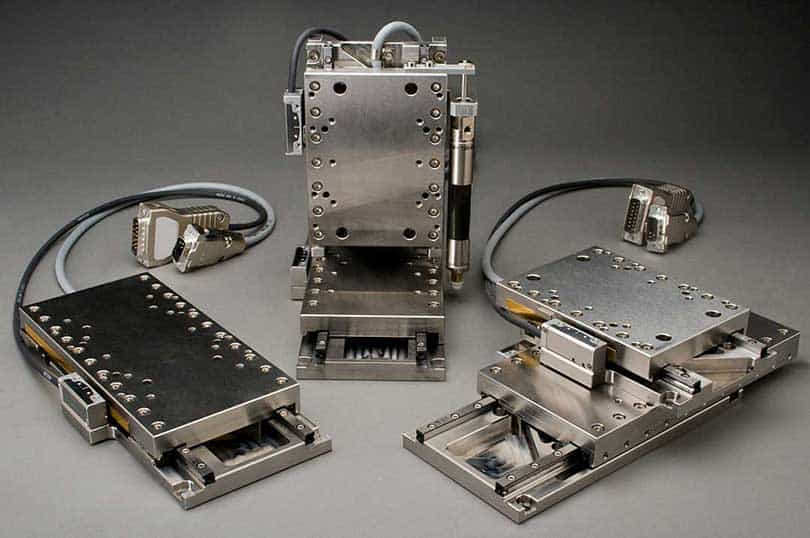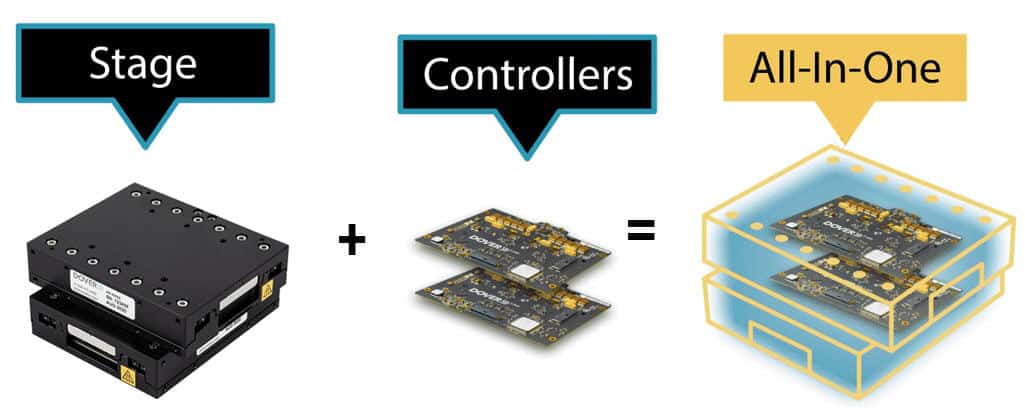Motion Control Systems
Motion control systems are capable of extremely precise speed, position, and torque control. Applications, such as life science and diagnostics microscopy, which require precise positioning of samples, synchronization of separate instrument elements, or fast start and stop motion, are all perfect candidates for the use of motion control.
The performance of the motion control systems is dependent on the mechanics, motion control electronics, and software used within the system. Typically, a motion control system consists of:
- motion controller
- drive
- motor
- device for position feedback

Motion Controller
A motion controller is a programmable device that controls the motion path, the servo loop closure, and the sequence execution in automated motion control systems. Basically, the controller is the “brains” of the motion control system.
Based on the motion requirements, the motion controller establishes the motion trajectory, sends control signals to the drive circuit to “drive” the motor, and in a closed loop system compares the actual position feedback signal from the encoder to the commanded trajectory, and uses the control loop to take corrective action if needed, ideally with little or no error.
Drive
Depending on the motion control system, either the main motion controller or drive utilizes position feedback devices such as resolvers and encoders to achieve high precision motion tasks. The drive receives low power signals or commands from the controller and then converts those signals to a high power signal that the motor needs to operate.
To do this, the drive (which supplies power to the motor) will vary output current to the motor to induce it to rotate or move linearly at a particular speed and direction. Think of this like the “muscle” needed to power the motor.
Motor
Motors perform tasks in motion control systems. Think of this like “hands” in our body metaphor. The motor converts the electrical energy to mechanical energy to power the system. There are three types of motors commonly used in precision motion control systems: Stepper, Servo, and Piezoelectric (also known simply as “Piezo”).
- Stepper Motor: A type of motor featuring two or four stator coils and a toothed permanent magnet rotor, which moves through a small angle (typically 1.8 degrees for 200 counts per revolution or 0.9 degrees for a 400 count per revolution motor) in response to a specific sequence of coil current changes.
- Servo Motor: A DC motor which produces a torque proportional to current. Precise positioning is achieved by linear analog or PWM (duty cycle) control of motor current or voltage, together with accurate monitoring of position via an external feedback device.
- Piezoelectric Motor: A motor that uses the inverse piezoelectric effect of varying voltage to shrink or expand a piezoelectric material to induce motion. This method converts the electrical energy into mechanical energy.
Feedback Systems
Optical Encoders are used for a majority of precision motion control applications. An encoder readhead sends light, typically in the visible or IR spectrum towards a scale with a diffraction grating. The reflected light from the grating is then processed by the encoder readhead detector and the pulses are used to determine changes in position between the encoder readhead and the scale.
Laser interferometers provide the ultimate in position feedback, combining very high resolution, non-contact sensing, high update rates, and intrinsic accuracies of 0.1 ppm.
They can be used in positioning systems as either passive position readouts, or as active feedback components in a position servo loop. Unlike linear optical encoders, the interferometer beam path can usually be arranged to coincide with the item or point being measured, eliminating, or greatly reducing errors due to Abbé offset.


Discover Our Innovative Motion Control System
”Dover Motion is more than a lot of companies, pushing the boundaries of developing new ways of executing motion, and seem creative in that way.“
Motion Control System Technology with All-In-One Controller Built-In


Key benefits of Dover Motion’s all-in-one package with SmartStage Controller built in:
- Reduced complexity, from 4 cables for XY to only 1
- Just supply power and communications
- High Precision feedback with 5nm resolution encoder
- Reduce XY footprint by up to 400%, eliminate external motion controllers, and save space in your instrument
- Compatible with Motion Synergy™ API - all-in-one motion control software API and user interface solution
SmartStage and DOF-5 Advanced Motion Control System Features
- Easily drive the DOF-5 from an autofocus sensor via noise-free digital signals, in Step-Direction or A-quad-B formats, for continuous tracking objective focusing.
- SmartStage XY product’s built-in Trigger On Position (TOP) output facilitates precise synchronization of a camera, laser, or other peripheral device with stage position. This high speed triggering is ideal for TDI Scanning microscopy applications.
- The DOF-5 and SmartStage XY support synchronized motion between axes.
- Stage Accuracy Compensation (SAC) provides accurate positioning at the user’s point of interest, negating Abbe and other trajectory-based errors.
- Dover Motion’s proprietary Repetitive Motion Enhancement (RME) algorithm improves step and settle performance for significant throughput gains.
Motion Synegy™ API Software
Software development does not have to take much of your budget and time. We’ve developed Motion Synergy API software that is compatible with Dover Motion’s products. It features:
- Out of the box programmable interface for rapid development
- Robust supported libraries
- Multiple interface options including .NET, C++, Python, LabVIEW, LUA scripts
- Compatible with Windows 10, Windows 11, Linux Ubuntu 22.04 LTS, Linux Ubuntu 20.04 LTS
- Built in logging and sample programs
Custom Motion Solutions
- Quick modifications tailored to your specific needs
Dover Motion offers a broad range of standard positioning stages. Our real strength, however, lies in our ability to design custom, application-specific solutions to OEM requirements.
In our custom systems, we draw from a broad palette of positioning technologies, and produce creative, cost-effective solutions that are precisely tailored to the needs of your application. Contact Dover Motion today to design your unique motion system.
We offer our own stepper and servo drive and control module and also partner with leading motion control suppliers to configure optimum servo and stepper control solutions for your particular application. This includes complete servo tuning, initialization and homing routines, and creating sample motion programs where you can add the specific requirements of your application to our stage assembly. Dover Motion’s control system engineers have the experience to successfully integrate additional customer specified controllers based on the application needs.
We have control theory experts on staff and we use the mathematical models of the servo loop filters in our motion control systems to predict system behavior. During testing, we optimize step and settle, position stability, and constant velocity performance.
We provide complete single-axis servo and stepper drives and controls with very sophisticated cutting edge capabilities in the size of a postage stamp. This type of motion controller can be embedded in the moving axes of your system or provided in more traditional external control boxes.
We support a range of stepper solutions such as:
- Very fine microstepping
- Complete suppression of mid-range resonance
- No motion jitter
- Very high speed
- Maximized speed torque curve performance
We have extensive experience with high-end motion control algorithms including r-theta controlled gantries, adaptive feed forward, and trajectory shaping. We also use bode plots, low pass filters, and other loop filter techniques to suppress resonances and provide the highest possible bandwidth.
Our servo motion controller system hardware and software solutions can be combined with any of our standard or configured stage designs to create a complete motion control solution. We offer motor drives and motion controller options that complement our motorized linear actuators and rotary stages.
Our stepper and servo motion controller product lines include everything from pre-packaged controllers, drives, and amplifiers to board-level and standalone units for customer integration. Depending on your requirements, USB, Ethernet, RS232, RS-485, CAN, SPI, and other computer interfaces are available.
Our expertise from years of experience with multiple motion control platforms include:
- Cable and joystick options
- Motion control programming
- Stepper motor setup
- Servo motor tuning
- Linear and rotary encoder implementation and interpolation
- Graphic User Interface setup, including NI LabVIEW
- Coordinated linear and circular moves
- Multi-point and multi-axis compensation
- Optimal move profile creation to reduce resonances
- Digital and analog I/O setup
- Power supply selection
- ROHS compliant design and manufacturing
- SEMI certification
- CE certification
There are several factors to consider when choosing the right motion control system for a particular application:
- Type of motion: Different types of motion control systems are better suited to different types of motion. For example, a system that uses a servo motor which provides high levels of torque at high speeds and operate at 80 – 90% efficiency may be more appropriate for controlling precise, fast positioning motion, while a system that uses a stepper motor which offers precision drive control, has a high torque at low speeds, and are also relatively inexpensive may be more suitable for controlling more substantial loads at lower speeds.
- Load requirements: The type of motion control system you choose should be able to handle the load requirements of your application. This includes the weight of the load, as well as any forces that may be acting on it, such as torque or thrust.
- Precision: The precision of the motion control system is important, particularly for applications such as diagnostics within life science, where precise positioning or control is required. You should consider the accuracy and repeatability of the system, as well as any features that may be useful for achieving the desired level of precision, such as encoders or feedback sensors.
- Cost: The cost of the motion control system is an important consideration, particularly if you are working with a limited budget. You should consider the initial cost of the system, as well as any ongoing maintenance or repair costs.
- Compatibility: The motion control system should be compatible with any other equipment or systems that it will be used with. This includes any controllers, motors, or other components that are required for the motion control system to function.
- Ease of use: It is important to choose a motion control system that is easy to use and understand. This can help to reduce the risk of errors. Our applications engineers will work with you to ensure a seamless integration into your instrument.
With more than 50 years of experience in the life sciences, diagnostics, and factory automation industries, we understand your needs and industry and can provide you the flexibility you need to hit your cost and schedule targets. Whether your project requires a customization to a standard product or a completely custom design, we’ll collaborate with your team to ensure we hit the most challenging design, cost, and schedule targets.
Contact us to learn more about expertise in precision automation and how we can create the right motion solution for you.








